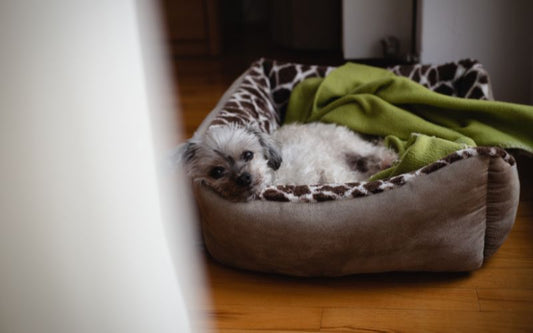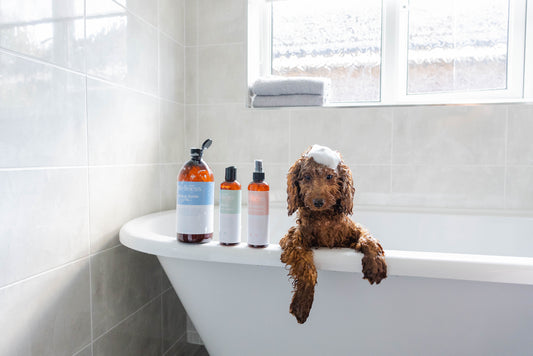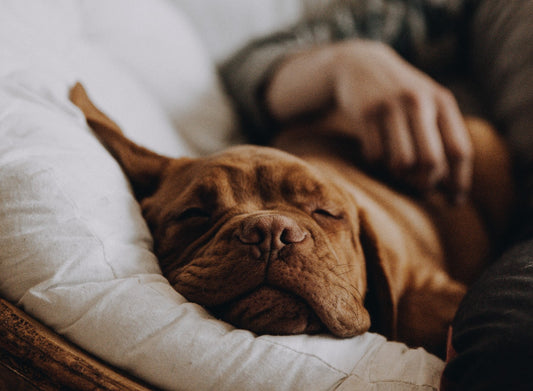If you’ve decided to introduce a new puppy to your family, congratulations! This can be a really fun time for the family and there’s no doubt you’ll be feeling excited to relive the puppy years all over again.
Before bringing your puppy home, it’s a good idea to understand how other animals in your household may react to the new arrival of a young and energetic puppy.
You might be wondering how to introduce a new puppy to your dog in a way that ensures a smooth transition. The good news is that there are lots of steps you can take to ensure your puppy gets welcomed home with open paws!
Find the information you need:
- When can my puppy meet other dogs?
- How do I get my dog to accept a new puppy?
- How to introduce a puppy to a dog:
- Will my dog get jealous of a new puppy?
- How long does it take dogs to get used to each other:

When can my puppy meet other dogs?
Your puppy will be able to explore outdoor areas and meet other dogs two weeks after their second round of vaccinations. Until your puppy has been fully vaccinated, you should avoid letting them socialise with other unfamiliar dogs that you don't know the vaccination status of.
Puppies tend to be brought home from the age of 8 weeks, and at this point, they won’t have received all of the necessary vaccinations to keep them safe from viruses. For this reason, you should avoid letting your puppy meet other dogs until they have been fully vaccinated.
How do I get my dog to accept a new puppy?
While lots of adult dogs will be excited to welcome a young friend into the fold, this is never guaranteed to happen straight away. It’s important to consider both:
- Your dog’s personality type and temperament:
- How and where your puppy and dog will first meet:
Neutral, outdoor spaces are ideal locations for introducing a puppy to a dog. This is because inside the house, your dog may feel territorial and behave defensively.
If your puppy hasn’t been fully vaccinated and isn’t able to be taken for a walk or a short trip to the park, then a good alternative is a garden. As mentioned earlier, you should not take your puppy to public areas prior to them receiving their vaccines.
How to introduce a puppy to a dog:
On the day your puppy is due to arrive home, it’s a good idea to ask a friend or family member to help you with the introductions. This way, there will be two people paying attention to each dog, and you won’t feel as stressed trying to coordinate the interaction.
Once you've chosen the right location, follow these simple steps to introduce pup to your resident dog:
- Take your dog to the garden. Ask the person helping you with the introductions to wait in the fenced outdoor area with your dog.
- Calmly and gently approach with puppy. Keeping both dogs are on a loose lead, walk over and calmly greet your dog, allowing the dogs to approach each other.
- Monitor your dog's body language closely. Make sure the adult dog isn’t showing signs of hostility, being too rough or overly playful. If you notice signs of fear when observing your puppy, remove them from the situation to somewhere they will feel more comfortable.
- Allow the dogs to interact with each other. You may notice that they start to sniff, circle around one another or begin to play. If everything is going well, you can drop the leads and let them engage naturally.
- Provide praise without micro-managing. As your puppy and dog socialise with each other, encourage their interactions with positive reinforcement. Verbally praising dogs can help to motivate behaviour and build a solid foundation for their relationship moving forward.
Please note: Some dog trainers recommend introducing a puppy to a dog off-leash to allow for a more natural meeting. If you want to get more information about this, contact your vet for specific advice.
If you find that the dogs ignore each other at first, try not to worry about it. Avoid forcing social interactions between your dogs and allow things to develop at a natural pace, this will help both your dog and puppy feel comfortable in their shared space.
Will my dog get jealous of a new puppy?
Whenever you introduce a new puppy to a dog, there’s a chance they may feel put out at first and demonstrate jealous behaviour.
Over time, dogs develop close bonds with their owners. Just like humans, dogs are able to release oxytocin, and interestingly, this chemical can have an affect on behaviours like insecurity and jealousy.
With this in mind, it’s not surprising that some dogs experience jealousy over an owner they trust and share an emotional connection with.
There tend to be two main reasons why dogs get ‘jealous’ of new puppies, and these are:
- Insecurity
- Dominance
While dominance is not an inherent personality trait, it is a type of behaviour that can occur in certain situations (like the arrival of a new puppy, for example). When dogs exhibit dominant behaviour, it’s important to correct them in a way that doesn’t cause insecurity, or friction between the two dogs.
If you’re worried about how to introduce your puppy to a dominant dog that lives in your household, then you can follow these steps to manage the situation for maximum success:
- Feeding: Food and water bowls can be kept in separate areas if you find your dogs squabbling or stealing during feeding time.
- Treats & Toys: Try to be as fair as possible with resources like toys. If your puppy is given new toys, aim to do the same for your dominant dog to avoid feelings of jealousy
- Correcting Behaviour: When dogs try to show dominance, they may growl when your puppy approaches something that they value. To counter-condition this behaviour, you can use the ‘sit’ or ‘lie’ commands before rewarding your dog with treats to help them realise that a puppy approaching is not a bad thing.
- Positive Attention: Make time for one-on-one bonding with each pet, and try your best to balance attention for both animals
- Develop their Bond: Invest in relationship building activities that can help your puppy and dog to bond. Joint activities include daily walks, playtime and cuddles during down-time.
How long does it take dogs to get used to each other?
While no two relationships are the same, it can take up to one month for a new puppy and dog to get used to each other.
When considering welcoming a second pet into your home, you must be prepared to put time and effort into building their relationship slowly over time.
After the initial introductions, continue to work on your dog and puppy’s relationship. All parents want their children to get along, but as with anything in life, relationships and trust take time to build.


